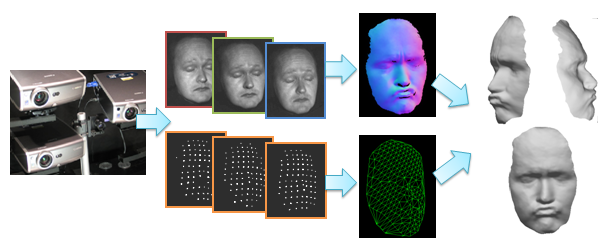| Summary |
| We present a new photogeometric framework for acquiring highly-detailed models of 3D objects and using these models for enabling interactive and close-up digital inspection. Our framework meets design goals of being fast, robust, and easy-to-use. Further, our framework demonstrates a setup of off-the shelf digital projectors and cameras, without any prior calibration, that enables a trade-off from coarse acquisitions to highly-detailed and optimized models. A key inspiration for our framework is that of simultaneously supporting a photometric and geometric-based approach thus producing a photogeometric modeling system. This combination permits selfcalibration, capitalizes on the high-visual details of photometric methods, and supports the precision of a geometric technique. |
| Modeling Moving and Deforming Objects using Sparse Geometric and Dense Photometric Measurements |
| Modeling moving and deforming objects requires capturing as much information as possible during a very short time. When using off-the-shelf hardware, this often hinders the resolution and accuracy of the acquired model. Our key observation is that in as little as four frames both sparse surface-positional measurements and dense surface-orientation measurements can be acquired using a combination of structured light and photometric stereo, resulting in high-resolution models of moving and deforming objects. Our system projects alternating geometric and photometric patterns onto the object using a set of three projectors and captures the object using a synchronized camera. Spatial-temporal photogeometric reconstructions are performed to obtain dense and accurate point samples with a sampling resolution equal to that of the camera. Temporal coherence is also enforced. |
 |
| Photogeometric Structured Light |
| Structured-light methods actively generate geometric correspondence data between projectors and cameras in order to facilitate robust 3D reconstruction. We present Photogeometric Structured Light whereby a standard structured light method is extended to include photometric methods. Photometric processing serves the double purpose of increasing the amount of recovered surface detail and of enabling the structured-light setup to be robustly self-calibrated. Further, our framework uses a photogeometric optimization that supports the simultaneous use of multiple cameras and projectors and yields a single and accurate multi-view 3D model which best complies with photometric and geometric data. |
 |
 |
| Digital Inspection: An Interactive Stage for Viewing Surface Details |
| In a wide range of applications, we often wish to quickly inspect and visualize historically significant and highly detailed objects. For such scientific illustration applications, often the focus is on high-frequency surface details and on conveying important shape and feature information. In this work, we provide a complete system to visualize objects on the spot. Our approach uses photogeometric processing, combined with a set of visualization methods tuned to the interactive inspection and analysis of objects. Highly accurate models are acquired in about 30 seconds using an uncalibrated setup, obtaining both detailed surface geometry and detailed surface normal information. Subsequently, captured objects are visually tracked enabling hand-held manipulation and visualization. |
 |
 Research supported in part by NSF MSPA-MCS Grant No. 0434398 Research supported in part by NSF MSPA-MCS Grant No. 0434398 |

|

